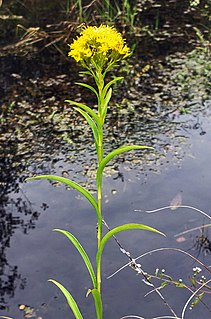
Solidago, commonly called goldenrods, is a genus of about 100 to 120 species of flowering plants in the family Asteraceae. Most are herbaceous perennial species found in open areas such as meadows, prairies, and savannas. They are mostly native to North America, including Mexico; a few species are native to South America and Eurasia. Some American species have also been introduced into Europe and other parts of the world.

Isocoma, commonly called jimmyweed or goldenweed, is a genus of North American semi-woody shrubs in the family Asteraceae. It is found in the semi-arid areas of Southwestern United States and Mexico.

Solidago houghtonii is a rare North American species of flowering plant in the family Asteraceae known as Houghton's goldenrod. It is native to southern Ontario, Canada and the northern United States. It is threatened by the loss and degradation of its habitat. It is a federally listed threatened species of the United States and it is designated a species of special concern by Canada's Committee on the Status of Endangered Wildlife in Canada.

Solidago velutina, the threenerve goldenrod or velvety goldenrod, is a plant species native to Mexico and to the western United States. The species has been found in southwestern Oregon, east to the Black Hills of South Dakota, and as far south as México State in the central part of the Republic of México. It is classified as a member of Subsection Nemorales.
Solidago juliae, known as Julia's goldenrod, is a plant native to central and western Texas, as well as southern Arizona, Chihuahua, Coahuila and Nuevo León. It occurs in grasslands, woodlands, and on freshwater shores.
Erigeron sceptrifer is a North American species of flowering plant in the family Asteraceae known by the common name scepter-bearing fleabane. It has been found in northern Mexico and the southeastern United States.

Solidago simplex, the Mt. Albert goldenrod or sticky goldenrod, is a North American plant species in the genus Solidago of the family Asteraceae. It is widespread across much of Canada, parts of the United States, and northeastern Mexico.

Solidago riddellii, known as Riddell's goldenrod, is a North American plant species in the genus Solidago of the family Asteraceae. It grows primarily in the Great Lakes and eastern Great Plains of Canada and the United States. It is sometimes considered part of the genus Oligoneuron, but as a Solidago, included in the section Solidago sect. Ptarmicoidei, the flat-topped goldenrods.
Solidago durangensis is very rare Mexican species of flowering plants in the family Asteraceae. It is known only from a few collections made in the 1890s near the city of Durango in northern Mexico, and not seen since. It is very likely now extinct.
Solidago hintoniorum is rare Mexican species of flowering plants in the family Asteraceae. It has been found in Nuevo León, Tamaulipas, and Coahuila in northeastern Mexico.
Solidago ericamerioides is rare Mexican species of flowering plants in the family Asteraceae. It has been found only in the state of Nuevo León in northeastern Mexico.
Solidago macvaughii is a rare plant species native to Mexico. The species is known from only two locations in the state of Aguascalientes in Mexico.
Solidago orientalis is a rare plant species native to Mexico. The species has been found in the states of Coahuila and Nuevo León in northeastern Mexico.
Solidago faucibus, the gorge goldenrod, is North American species of flowering plants in the family Asteraceae. It was recognized as a distinct species in 2003. It is found primarily in the southern Appalachian Mountains of the southeastern United States, in the states of Virginia, West Virginia, Kentucky, Tennessee, and South Carolina. It is found in mesic forested gorges, often growing under Tsuga canadensis.

Solidago nana is a North American plant species in the family Asteraceae, with the common names baby goldenrod and dwarf goldenrod. The species is native to deserts and mountainsides in the western United States, from the Rocky Mountains to the Great Basin in the states of Idaho, Montana, Nevada, Utah, Wyoming, Colorado, Arizona, and New Mexico.

Solidago uliginosa, or bog goldenrod, is a North American species of flowering plants in the family Asteraceae. It is found in eastern Canada and the eastern United States.
Solidago wrightii, commonly known as Wright's goldenrod, is a North American species of goldenrod in the family Asteraceae. It grows in northern Mexico and the southwestern United States.
Isocoma gypsophila is a Mexican plant species in the family Asteraceae. It has been found in the States of Zacatecas and Nuevo León.
John Cameron Semple is a botanist, cytotaxonomist, professor emeritus, and adjunct professor at the University of Waterloo in Ontario, Canada. He was born in Boston and earned a degree of Bachelor of Science in 1969 from Tufts University, followed in 1971 and 1972 by Master of Arts and Doctor of Philosophy degrees from Washington University in St. Louis. Semple is known for his work with members of the tribe Astereae, particularly goldenrods, American asters, and goldenasters, and he maintains the University of Waterloo Astereae Lab website. Semple's wife is Brenda, and in 2013, he named a newly-discovered goldenrod species Solidago brendiae in honor of her.
Sanrobertia is a monotypic genus of flowering plant within the subtribe Symphyotrichinae of the family Asteraceae. Sanrobertia gypsophila is endemic to Nuevo León, Mexico.








